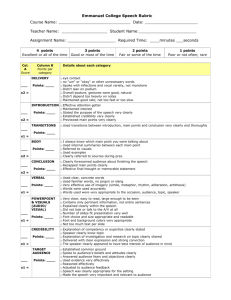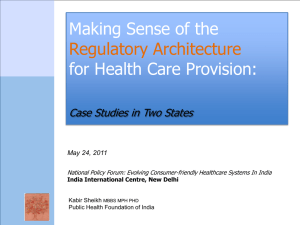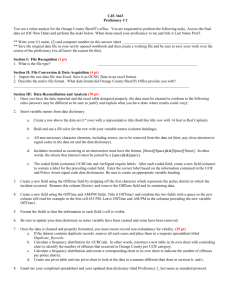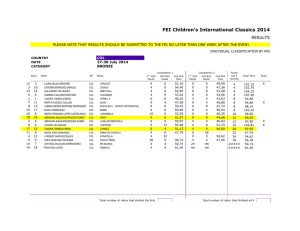AARL NOTES
advertisement
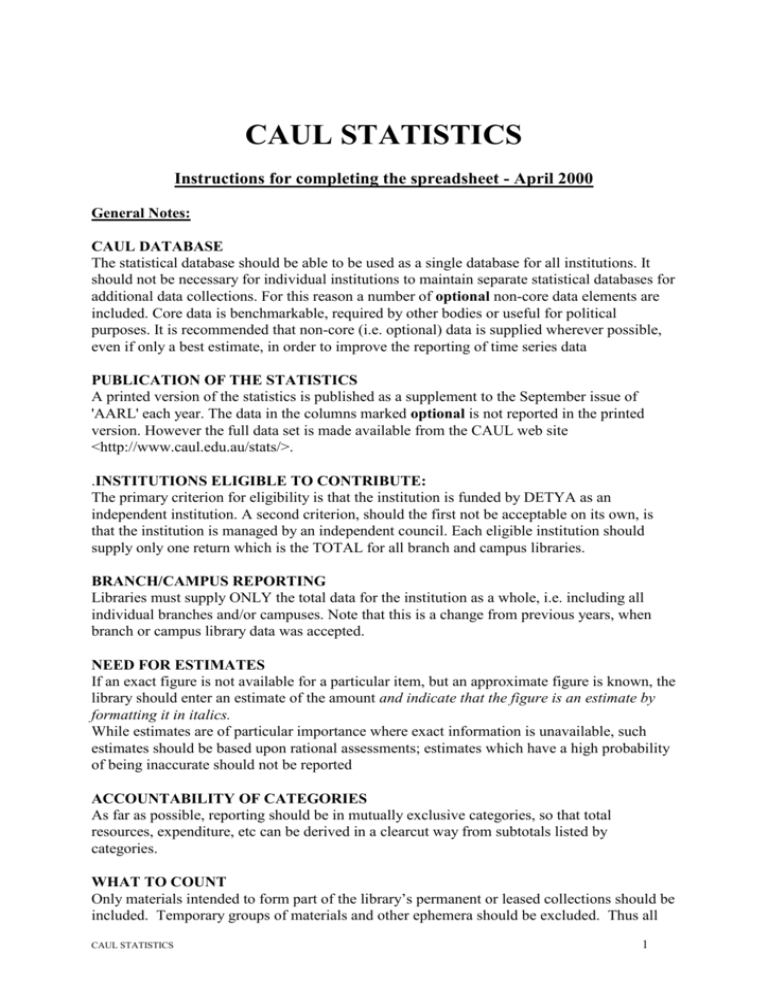
CAUL STATISTICS Instructions for completing the spreadsheet - April 2000 General Notes: CAUL DATABASE The statistical database should be able to be used as a single database for all institutions. It should not be necessary for individual institutions to maintain separate statistical databases for additional data collections. For this reason a number of optional non-core data elements are included. Core data is benchmarkable, required by other bodies or useful for political purposes. It is recommended that non-core (i.e. optional) data is supplied wherever possible, even if only a best estimate, in order to improve the reporting of time series data PUBLICATION OF THE STATISTICS A printed version of the statistics is published as a supplement to the September issue of 'AARL' each year. The data in the columns marked optional is not reported in the printed version. However the full data set is made available from the CAUL web site <http://www.caul.edu.au/stats/>. .INSTITUTIONS ELIGIBLE TO CONTRIBUTE: The primary criterion for eligibility is that the institution is funded by DETYA as an independent institution. A second criterion, should the first not be acceptable on its own, is that the institution is managed by an independent council. Each eligible institution should supply only one return which is the TOTAL for all branch and campus libraries. BRANCH/CAMPUS REPORTING Libraries must supply ONLY the total data for the institution as a whole, i.e. including all individual branches and/or campuses. Note that this is a change from previous years, when branch or campus library data was accepted. NEED FOR ESTIMATES If an exact figure is not available for a particular item, but an approximate figure is known, the library should enter an estimate of the amount and indicate that the figure is an estimate by formatting it in italics. While estimates are of particular importance where exact information is unavailable, such estimates should be based upon rational assessments; estimates which have a high probability of being inaccurate should not be reported ACCOUNTABILITY OF CATEGORIES As far as possible, reporting should be in mutually exclusive categories, so that total resources, expenditure, etc can be derived in a clearcut way from subtotals listed by categories. WHAT TO COUNT Only materials intended to form part of the library’s permanent or leased collections should be included. Temporary groups of materials and other ephemera should be excluded. Thus all CAUL STATISTICS 1 materials which can be readily identified and located for use by cataloguing, classification, filing lists, checked bibliography or a combination of other methods, would be counted. REFERENCE DATES The reference date for all data is 31 December of the reported year, except data relating to staff and students (cols. 6-11 & 52-67), where 31 March of the reported year should be used. If the institution operates on a financial rather than calendar year, figures should still be provided and this fact should be indicated in a footnote. COMPLETION OF SPREADSHEET Please enter data directly into the spreadsheet. If the information for any column is not available enter NA. If the information is not applicable then leave the column blank. Notes on the Spreadsheet: LIBRARY NAME Enter the full name of the institution, not an abbreviation or a code. YEAR Enter the calendar year to which these statistics apply. STATE Australian Libraries enter the State and New Zealand libraries 'NZ'. LIBRARY ORGANISATION - Columns 1 to 5. COL. 1 - Number of libraries. Include the number of libraries in the institution under the control of the University Librarian. Libraries to be included are physically separate, entry to and exit from is controlled by the University Librarian and to which users have direct access. e.g. Bookmobile would count as a site; WWW is not a site; if one library is within another, then count as one; joint use libraries counted if they are controlled by the University Librarian; library store, which is staffed and to which users have direct access, is a site.. COL.1A - Floor space. OPTIONAL Buildings and Grounds Departments collect space for DETYA. This information should be obtained if required. COL.2 - Opening hours. The most common number of hours open per week during term/semester. The number of hours should refer to the Central Library only. The central library contains the central library administration and therefore usually the office of the University Librarian. If no Central Library select the one you believe most closely fits this description. Don't collect fractions of an hour. Seating This should be the total number of seats in the institution, including branches. Do not include seats at computer workstations or catalogues. CAUL STATISTICS 2 COL.3 - Number of formal study seats. Formal study seats are provided within the library at carrels, tables, etc in open or restricted reading areas and in assignable rooms where students can study and use the library materials. Also includes seating in AV collections, map libraries etc where students can work with library materials. COL.4 - Number of casual seats. Casual seats are provided within the library, normally without provision for writing, eg in display or other lounges, foyers, coffee shops if under library control, etc. Excludes visitors’ seats in offices, seats in waiting rooms, etc. COL.5 - Number of classroom seats. Classroom seats are provided within the library in seminar rooms, lecture theatres, microcomputer laboratories, language laboratories, etc and not normally available for individual study or use of library materials LIBRARY STAFF - Columns 6 to 11. Include fulltime equivalent for part-time and casual staff. COL.6 - Professional library positions. Under Professional Librarian positions count all library staff engaged primarily in specialist library work, library administration or library management, and occupying positions for which the normal requirements are a university degree or equivalent qualifications and eligibility for professional membership of ALIA. COL.7 - Para-professional library positions. Under Para-Professional positions count all library staff engaged in positions for which a Library Technician qualification (ie certificate, associate diploma, etc, at a sub-bachelors degree level) is required. COL.8 - Library support positions. Under Library support staff positions count all administrative and clerical assistants, secretarial and word processing staff, and library attendants, as well as graduates without library qualifications, but engaged in specialist library-related duties. COL.9 - Other professional positions. Under Other Professional staff count all professional staff, such as accounting or IT staff, who are not engaged in specialist library work. COL.10 - Other positions not elsewhere classified. COL.11 - Total Staff (Sum of columns 6 to 10) HEW LEVELS COL.11A - Number of staff at HEW1 level COL.11B - Number of staff at HEW2 level COL.11C - Number of staff at HEW3 level COL.11D - Number of staff at HEW4 level CAUL STATISTICS OPTIONAL OPTIONAL OPTIONAL OPTIONAL OPTIONAL 3 COL.11E - Number of staff at HEW5 level COL.11F - Number of staff at HEW6 level COL.11G - Number of staff at HEW7 level COL.11H - Number of staff at HEW8 level COL.11I - Number of staff at HEW9 level COL.11J - Number of staff at HEW10 level COL.11K - Number of Other staff OPTIONAL OPTIONAL OPTIONAL OPTIONAL OPTIONAL OPTIONAL OPTIONAL LIBRARY SERVICES - Columns 12 to 21 Loans. Circulation is influenced by discipline and loan length. Loans data is therefore not comparable. However it is needed for internal purposes within institutions. It is a measure of activity, not service. If loans were to be published, a circulation index would have to be included. COL.12 - No longer used COL.13 - No longer used COL.14 - Total number of loans. OPTIONAL Include the number of loans and renewals made of all material in the library’s collection but not equipment. Include loans to all registered borrowers, but exclude interlibrary loans and borrowings, lending between campuses or branches, from storage to a branch, and reserve loans. Under renewals include the number of formal extensions to a loan period for material which has previously been loaned. COL.15 - Number of Reserve Collection Loans. OPTIONAL Reserve collection loans are to include the number of loans made of all material in the library’s reserve collection, including monographs, videos, sound recordings, etc. Reserve loans are short term loans, eg overnight loans or loans of less than 24 hours to users who cannot remove material from the library’s premises. Document Delivery Services Document Delivery Services refers to transactions outside the library, or between libraries, or between libraries and document supply services, whether libraries or other organisations. Document Delivery Services requests for loans or copies, is to include all items obtained from outside the library system, which are not for inclusion in the collection, and which are obtained at the request of a specific client for their own personal use. End user initiated transactions that are paid for by the library, either directly or quid pro quo, should be counted. Do not count the number of pages supplied. Supplied to others. COL.16 - No. of original items supplied (including loans of videos, films, sound recordings, monographs etc) COL.17 - No. of items supplied by photocopy or electronic mail etc. COL.18 - Total no. of bibliographic items supplied CAUL STATISTICS (Sum of Cols 16 and 17) 4 Received from others. COL.19 - No. of original items received (including loans of videos, films, sound recordings, monographs etc) COL.20 - No. of items received by photocopy or electronic mail etc. COL.21 - Total no. of bibliographic items received (Sum of Cols 19 and 20) Inter-campus and inter-branch lending COL.21A - No. of items supplied OPTIONAL Include here all the exclusions as defined for Column 14 .i.e lending between campuses or branches or the central library, from storage to a branch, loans and copies. Only count items supplied from the lending branch or campus library. INFORMATION RESOURCES - Columns 22 to 43 Breakdown is by bibliographic level i.e. serial or non-serial. Non-serial includes monographs and other non-serial works in any medium or format. Do not break down by physical format i.e. book, non-book, electronic. Non-serial items A non-serial item, or volume, is a single unit holding of the library distinguished from the other single units by a separate binding, encasement or other clear distinction. Items of all formats are to be counted, and will include electronic and non-book, as well printed, typed or handwritten works contained in one binding or portfolio or bound which have been catalogued, classified or otherwise made ready for use. Pieces stored together in a box or a bag etc should be counted as one and each individual component e.g. slide, microfiche, overhead transparency should not be counted COL 22 - Number of non-serial items acquired by purchase during the year COL.23 - Number of non-serial items acquired by gift or exchange during the year A withdrawn non-serial item is no longer held and holdings are written off from the library records, owing to loss, etc. COL.24 - Number of items withdrawn during the year COL.25 - Total non-serial volumes in library at the end of the year (Sum of last years total + col.22 + col.23 - col.24) Non-Serial Titles Include under non-serial titles all formats. COL.26 - Number non-serial titles acquired by purchase during the year. OPTIONAL COL.27 - Number non-serial titles acquired by gift or exchange during the year.OPTIONAL CAUL STATISTICS 5 A withdrawn non-serial title is no longer held and holdings are written off from the library records, owing to loss, etc. COL.28 - Number of non-serial titles withdrawn during the year. OPTIONAL COL.29 - Total non-serial titles in library at the end of the year (Sum of last years total + col.26 + col.27 - col.28) OPTIONAL Serial information resources A Serial is a publication in successive parts, usually at regular intervals, and as a rule, intended to be continued indefinitely. Serials include periodicals, newspapers, annuals (reports, yearbooks, etc), memoirs, proceedings and transactions of societies; they may include monographic and publishers’ series. Monographic and publishers series are to be counted as serials only if the individual volumes within the series are not classified and catalogued separately. Multi-volume works are not to be counted as serials unless they are intended to continue indefinitely. Serials may be in electronic, print or non-print formats. Non-print includes microform, audio or video tapes. Electronic includes CDROM. Electronic serials may be served in-house or from a remote server, may be individual titles or part of aggregations. Large, uncatalogued collections of electronic serials are comprised of: known unique titles; known duplicate titles and other that includes titles to which the library has access but has not established whether they are unique or not e.g. Lexis-Nexis. If unsure, assume the title is unique. Count the number of individual titles on the database. For full-text electronic databases, count each serial title separately. For bibliographic databases, count the database as one title e.g. WorldCat. Serial volumes. Serial volumes generally refer to physical items A Bibliographic volume in relation to serials, is the volume designated by the publisher of the serial and given a distinguishing number. If no volume number is assigned to a serial, a “bibliographic volume” is to be taken to comprise one calendar year’s issue or issues of the serial. If counting "electronic volumes" they are to be counted as bibliographic volumes. COL.30 Total no.of bibliographic volumes added (Sum of COL.30A and COL.30B) OPTIONAL COL.30A No. of print and non-print bibliographic volumes added OPTIONAL COL.30B No. of electronic bibliographic volumes added OPTIONAL COL.31 Total no of bibliographic volumes withdrawn (Sum of COL.31A and COL.31B) OPTIONAL COL.31A - No. of print and non-print bibliographic volumes withdrawn OPTIONAL COL.31B - No. of electronic bibliographic volumes withdrawn OPTIONAL Bound volumes are the serials which the library designates as a volume by virtue of binding them into one unit. COL.32 - No. of bound volumes added. OPTIONAL COL.33 - No. of bound volumes withdrawn OPTIONAL CAUL STATISTICS 6 COL.34 - Total no. of serial volumes in the collection OPTIONAL (Sum of last year's total + col.30 - col.31 or Sum of last year's total + col.32 - col.33) Serial titles The number of current serial titles is to be counted. Distinguish between current and noncurrent serials. The number of new serials titles, excluding duplicates, is to be counted. The number of actively cancelled serials titles is to be counted. Distinguish between unique and duplicate titles of current serials. If unsure, assume the title is unique. Do not count the total number of serial titles in the collection. If an electronic database, in-house or remote, is full-text, then count each title separately. A new serial title ( COL. 35) has been made available in the Library for the first time this year. Where two or more copies of the same new title are received, they should be counted as one new title only and the duplicate title(s), where these can be idenified, should be counted as DUPLICATE titles. A new microform or electronic title should be counted only if the title is not already held in another format. Change of title of a serial does not mean it is a new serial. Purchase of backsets of serials should not be shown as new titles, they are to be treated as additions to holdings of bound/bibliographic serial volumes. COL.35 - New serial titles (sum COL35A and 35B) COL. 35A New print and non-print serial titles excluding electronic and CDROM titles. COL.35B New electronic titles whether individual titles or titles that are part of an aggregation and which do not duplicate those already held as print or non-print titles. Current serial titles (COLS. 36 & 37) are those to which the library has a continuous paid subscription, or has the expectation of receiving further issues by gift or exchange, as at 31 December each year, and of which the first issue has been received and catalogued or otherwise made available for use. Current titles received should not include DUPLICATE titles. When two or more copies of the same title are received regardless of format it should be counted as one new title only and the subsequent copies duplicate titles in the relevant column. Titles can be in any format, eg printed journals, electronic journals, journals on CD-ROM, etc. If not sure whether a serial title received electronically is a duplicate or not, assume the title is unique. COL.36 Current serial titles by paid subscription (excluding duplicates) (Sum of Cols. 36A and 36B) COL. 36A Current serial print and non-print serial titles, excluding electronic and CDROM titles acquired by paid subscription. COL. 36B Current serial electronic titles either individual titles or titles that are part of an aggregation and which do not duplicate already held print or non-print titles, acquired by paid subscription. COL.37 Current Serial titles by gift, exchange or gratis (excluding duplicates) (Sum of Cols. 37A and 37B) Only include titles that are either catalogued or made available for use. CAUL STATISTICS 7 COL. 37A Current print and non-print serial titles (excluding electronic and CDROM titles) by gift, exchange or gratis. COL. 37B Current electronic journals titles by gift, exchange or gratis, either individual titles or titles that are part of an aggregation and which do not duplicate already held print or non-print titles. COL.38 - Total number of unique current serial titles. (Sum of Col. 36 and Col. 37) COL. 38A Current print and non-print serial titles excluding electronic and CDROM titles (Sum of Col. 36A and Col. 37 A) COL. 38B Current serial electronic titles, either individual titles or to titles that are not part of an aggregation and which do not duplicate already held print or non-print titles (Sum of Col. 36B and Col. 37 B) Duplicate titles should include the second and subsequent serial titles, where they can be identified, to which the library subscribes, or received by gift or exchange. These titles need not be in the same format to be considered duplicate titles, eg. one title may be received as a printed journal and the same title may also be received on microform or electronically. If two or more titles are received, one will be counted under CURRENT UNIQUE TITLES (COL. 38) and the second and subsequent will be counted under DUPLICATE TITLES (COL. 39). COL.39 - Total number of duplicate current serial titles. (Sum of Cols. 39A and 39B,) COL. 39A Duplicate current print and non-print serial title excluding electronic and CDROM titles COL.39B Duplicate current electronic titles, either individual titles or to titles that are part of an aggregation. COL.40 - Number of serial titles actively cancelled (Sum of Cols. 40A and 40B) COL. 40A Actively cancelled print and non-print serial titles excluding electronic and CDROM titles COL. 40B Actively cancelled electronic titles, either individual titles or titles that are part of an aggregation. COL.41 - Total current serial titles (Sum of col.38 & col.39) AND (Sum of Col. 40A & 40B) COL. 41A Current serial print and non-print serial titles excluding electronic and CDROM titles (Sum of Col. 38A and Col. 39 A) COL. 41B Current serial electronic titles, either individual titles or titles that are part of an aggregation (Sum of Col. 38B and Col. 39 B) COL.41C - Shelving. OPTIONAL Count the linear metres of shelving mounted in the library system. Count the linear metres of shelving occupied by serials and non-serials, including microform cabinets and newspaper benches. Include the shelving in library stores and in all the sites controlled by the University Librarian. COL.42 - No longer used COL.43 - No longer used CAUL STATISTICS 8 LIBRARY EXPENDITURE - Columns 44 to 51 Report expenditure data under the following headings: Salaries - Include all associated costs Information Resources. Includes Serials subscriptions, which includes electronic serials and memberships that include a serial subscription. Non-serials, which includes backsets of serials, and gross expenditure on commercial document supply. Binding, which does not include bindery salaries. Operating Expenditure. All other expenditure, excluding tagged one-off grants for particular purposes, and which may include expenditure on a range of outsourced library services. Do not include depreciation, occupancy, and insurance. If any of these items have been included in institutional budgets, they must be excluded from the data supplied to CAUL. COL.44 - Non-serials. COL.45 - Serials Subscriptions Serial subscriptions should include expenditure on titles counted in columns 35 to 39. Expenditure on serials titles purchased in order to exchange for other serial titles should be included here. COL.46 - No longer used. COL.47 - No longer used. COL.48 - Binding Expenditure on Binding is to include payment to commercial binders and/or the cost of inhouse binding. Do not include staff costs. COL.49 - Operating expenditure. COL.50 - Salaries Salaries are to include bindery staff. Include all on-costs. COL.51 - Total Library Expenditure (Sum of cols. 44, 45, 48, 49 and 50) COL.51A – Extraordinary expenditure OPTIONAL Additional other non-operating expenditure or extraordinary expenditure e.g. capital works expenditure, computer system expenditure. CAUL STATISTICS 9 INSTITUTIONAL POPULATION - Columns 52 to 67 Population figures for all columns except Column 65A in this section are provided by DETYA. Therefore only New Zealand university libraries, and private universities for which DETYA does not collect statistics need to complete this section. TAFE population data should be excluded if at possible. If it is not possible, and TAFE students are included in Columns 60 and 61, then an explicit note should be provided. It will be assumed that the inclusion of TAFE population data implies that data in all other columns also includes TAFE. The levels of courses are defined by the Australian Qualifications Framework. Their web page is at <http://www.curriculum.edu.au/aqfab.htm>, the page titled 'The 12 AQF Qualifications' is the one used by DETYA. Column 65A should be completed if appropriate. To determine whether users are official or additional to the University population, ask the question - does the University expect services to be provided as part of their agreement with the person? Academic Staff. Academic staff includes those who are appointed principally to undertake a teaching only or research only or a teaching and research. For a full list of academic staff categories see DETYA's Higher Education Student Data Collection. COL.52 - Full-time and fractional full-time staff (persons) COL.53 - Full-time and fractional full-time staff (FTE) Other Staff. COL.54 - Full-time and fractional full-time staff (persons) COL.55 - Full-time and fractional full-time and casual staff (FTE) Students. Higher Degree. Higher Degree Students are split into two categories, Higher Degree Research (made up of Higher Doctorate, Doctorate by Research and Master's by Research) and Higher Degree Coursework (made up of Doctorate by Coursework and Master's by Coursework). COL.56 - Persons. COL.57 - EFTSU Other tertiary. Other Tertiary Students - This includes Postgraduate Students (students studying in the following courses: postgraduate qualifying/preliminary; graduate diploma/post graduate diploma - new and extension; and graduate certificate) and Undergraduate Students (defined as students studying in the following courses: Bachelor's Graduate Entry; Bachelor's Honours, Bachelor's Pass, Associate Degree, Advanced Diploma, Diploma and Other Award Course. (Note that the term Other Tertiary is not used by DETYA). CAUL STATISTICS 10 COL.58 - Persons COL.59 - EFTSU Non-tertiary. Non-tertiary Students are those who are enrolled in courses which do not lead to a tertiary award, eg Enabling courses, Cross Institutional Programs, Non-award Courses and Open Learning Studies COL.60 - Persons COL.61 - EFTSU Total Students COL.62 - Persons (Sum of cols 56,58 and 60) COL.63 - EFTSU (Sum of cols 57,59 and 61) External Students. External Students are those for whom the institution makes special arrangements whereby they need not attend the campus for lectures, tutorials or to have regular contact with a supervisor, in order to complete a course of study during the academic year. COL.64 - Persons (included in cols 56, 58 and 60) COL.65 - EFTSU (included in cols 57,59 and 61) Other Users. COL.65A - Other users (Persons) OPTIONAL Users not authorised by the University, but to whom the library provides a service e.g. community, reciprocal and short course borrowers. Institutional Population. Total institutional population should include all staff and students belonging to the institution, including non-academic staff. COL.66 - Persons (Sum of cols 52, 54 and 62) COL.67 - Full-time Equivalent (Sum of cols 53, 55 and 63) Turnstiles. COL.67A - Turnstiles. The total annual count. CAUL STATISTICS OPTIONAL 11
